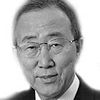In a world beset by so many challenges, problems and disputes, it is a sign of hope that more than 150 world leaders will gather this week at the United Nations to adopt a new vision for the future well-being of all humankind.
World leaders are coming to New York because they understand the need to steer the world onto a safer, more equitable and more sustainable trajectory. At the heart of the new agenda are the Sustainable Development Goals (SDGs): 17 bold yet achievable goals that aim to end poverty, fight inequality, tackle climate change and build peaceful societies by the year 2030.
Also known as the "Global Goals for Sustainable Development," the SDGs are the result of the most open and transparent consultation process in the history of the United Nations, in which individuals, community organizations, businesses, scientists, academics and other partners worked with Governments. Millions of people shared their vision for a better world and what is needed to attain it. The result is truly the people's agenda. The Goals are universal; they apply to all countries, since we know that even the wealthiest have yet to conquer poverty or achieve full gender equality. No one goal is more important than any other; they are integrated and mutually reinforcing. For instance, access to energy will allow a child to study at night. This energy might come from a solar source and therefore be tackling climate change. In turn, the solar-panel industry might be helping a developing country grow its economy. Greater opportunity to study, in turn, can lead to better job opportunities, innovation, and stronger national institutions.
The Goals also have strong links to our efforts to foster international peace and security. It is in countries affected by conflict where so much human need resides. We will not reach the SDGs without renewed resolve to end today's conflicts and violence. When hostilities start, so much else comes to a halt: schooling, vaccination campaigns, economic growth, development itself. At the same time, achieving the goals would help to prevent instability and violence. The new Goals therefore aim to promote just, peaceful and inclusive societies, access to justice and effective, accountable and inclusive institutions. A sustainable world will be a safer one.
Making such dramatic improvements in the span of 15 years will be no small feat. Yet we already know that global goal-setting works. The Millennium Development Goals, adopted in 2000, have improved the lives of millions of people. Global poverty continues to decline; more people have access to improved sources of water; more children than ever are attending primary school; and targeted investments in fighting malaria, AIDS and tuberculosis have saved millions.
But much more needs to be done, especially to reach the most marginalized and vulnerable and put us all on a sustainable-development path. The new agenda and Goals embody a commitment to leave no one behind. They are for millennials and grandparents, city dwellers and rural communities, employers and employees, developed and developing countries alike.
Just as so many people joined in the process of articulating the SDGs, achieving them requires effort from everyone, everywhere. The United Nations and I look forward to working with people across the world to bring the goals to life and to transform our world. That's the plan; that's the promise; let's get to work!
The author is Secretary-General of the United Nations.
This post is part of a series produced by The Huffington Post, "What's Working: Sustainable Development Goals," in conjunction with the United Nations' Sustainable Development Goals (SDGs). The proposed set of milestones will be the subject of discussion at the UN General Assembly meeting on Sept. 25-27, 2015 in New York. The goals, which will replace the UN's Millennium Development Goals (2000-2015), cover 17 key areas of development -- including poverty, hunger, health, education, and gender equality, among many others. As part of The Huffington Post's commitment to solutions-oriented journalism, this What's Working SDG blog series has focused on one goal every weekday in September. This post, published on the day the conference is scheduled to start, addresses all the Goals.
